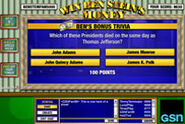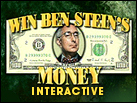| Host | |
| Ben Stein | |
| Co-Hosts/Announcers | |
| Jimmy Kimmel (1997–2000) Nancy Pimental (2000–2001) Sal Iacono (2002–2003) | |
| Broadcast | |
| Comedy Central: 7/28/1997 – 1/31/2003 | |
| Packagers | |
| Valleycrest Productions Comedy Central Buena Vista Television | |
Win Ben Stein's Money featured three contestants competing in a Q & A styled game against each other and eventually Ben Stein himself in an attempt to win $5,000 of his money.
Gameplay[]
The First Two Rounds[]
In these rounds, the contestants involved faced a board of five categories inside five picture frames (in the first season they appeared as cards, but from Season 2 onward, the cards were replaced with monitors). Each category was a pun hinting at the question's content, similar to Pyramid or the JD Roberto era of Shop 'Til You Drop. Even Jeopardy! had pun-laden categories, but only on occasion.
The controlling player picked a category, and then a dollar amount was revealed behind it after which a question was read (the questions were just heard in Season 1, but for the rest of the series, they were also seen on the monitor the chosen category appeared after the amount was revealed). The first player to ring in with the correct answer scored the hidden dollar amount from right out of Ben's total. After each question, a new category replaced the one chosen, and the last player to give a correct answer chose the next category.
The rounds were played in an unmentioned time limit, and ended when a cuckoo clock sounded. The player with the lowest score at the end of each round was eliminated from the game, and all the money he/she took was returned to Ben and added back to his total. Also, if at any point a contestant answered in the form of a question (as on Jeopardy!), Stein, in mock anger, would put a dunce cap on the offending player's head and he/she was forced to wear it for the rest of the round.
If either round ended in a tie, a tiebreaker question was read, and the first contestant to ring in with the correct answer advanced; an incorrect answer, however, had the opponent advance.
Round 1[]
The three contestants competed against each other, and Ben read all the questions (worth either $50, $100, or $150). Each time a contestant answered the first question correctly for the amount showing, that player had a chance to answer a $50 follow-up question; should everyone miss the first question, the follow-up became a toss-up for all three contestants.
Round 2[]
The survivors of Round 1 played not only against each other, but against Ben as well as he became a common contestant trying to defend his money; because of that, the co-host read all the questions, with the disclaimer that "From this point on, Ben has no advance knowledge of any of the questions to be asked." or that "This is the part of the show where we remind everyone that Ben does not get the answers to the questions ahead of time."
Ben would always stand at the third podium for this round. If a contestant got eliminated from the third podium, he would simply take over that spot. If a contestant got eliminated from the second podium, the second contestant moved one spot closer to make way for him entering the third podium. And if a contestant got eliminated from the first podium, both contestants would move one spot over or (later in the run) the contestant from the third podium would move to the first podium to make way for Ben.
This time, the question values increased to the range of $200-$500 in $100 increments to the contestants should they get them right; if Ben got a question right, his remaining total stayed the same. To accommodate this, the scoring display on his podium showed only a dollar sign. Ben made the first selection in this round, and there were no follow-ups.
The contestant with the most money at the end of this round got to keep it and would take on Ben for the rest of his money. If there was a tie, the tiebreaker question was asked without Stein answering.
Final Round: Best of 10 Test of Knowledge[]
This round was so-called because the last contestant and Ben were both asked the same 10 questions, but they played individually/one at a time. To start, the contestant had a choice to go first or second, and then they sat in their own isolation booths (the contestant sat in a dirty plain wrap booth with a hardwood stool and a bare hanging light bulb, while Ben sat in a beautifully decorated one with a leather-wing back chair and other lavish furnishings). Whoever played second wore headphones so they couldn't hear the other's answers.
Each player had 60 seconds (one minute) to answer as many of the ten questions as possible, and whoever answered the most won. Missed or passed questions couldn't be returned to, but the co-host went over them after the first player was done. If Ben won, the contestant only received the money he/she won from the first rounds; if both players were tied, the contestant won $1,000 on top of his/her prior winnings; and finally, if the contestant managed to beat Stein and win, he/she won all $5,000 of Ben Stein's money (his/her prior winnings were augmented to the grand prize amount; in the earliest-taped episodes of the first season, however, the entire $5,000 was awarded in the event of a tie as well).
"Ben Stein's Cup" episodes[]
On two occasions in Season 4, three of the show's best contestants (who had already won $5,000) returned for a special "Ben Stein's Cup" episode, for a chance to win five times the amount ($25,000). The question values in the main game were multiplied by four; so in Round 1, the values were $200, $400, and $600 (with follow-up questions worth $200), and in Round 2, the questions were worth $800-$2,000 in increments of $400. The winner attempted to beat Ben for the entire $25,000.
Additional Note[]
Due to Ben's high IQ (let alone his aggressive competition), most contestants didn't win the full top prize. Logically, the show's overall win rate was roughly 15.376%.
Music[]
Various pieces of classical music were used throughout the show, and consisted of the following:
Ben Stein's Intro – "Wachet auf, ruft uns die Stimme" ("Awake, the voice is calling us") by Johann Sebastian Bach
Open – "Ode to Joy" by Ludwig Von Beethoven
1st Commercial Intro – "Water Music" by George Frederic Handel
1st Commercial Outro – "Spring" by Antonio Vivaldi
2nd Commercial Intro – "Eine Kleine Nachtmusik" ("A Little Night Music") by Wolfgang Amadeus Mozart
3rd Commercial Intro – "Trepak" by Pyotr Ilych Tchaikovsky
3rd Commercial Outro – "Night on Bald Mountain" by Modest Petrovich Mussorgsky
Close – "Ride of the Valkyries" by Richard Wagner (this was also played in the players' headphones in the booth to prevent them from hearing the opponent's answers)
Studio[]
Hollywood Center Studios, Los Angeles, CA
Rating[]
Trivia[]
- At one time during the third season, Ben & Jimmy traded jobs for one episode up to the Best of 10 Test of Knowledge.
- A second season episode was one of the most talked about, for on that show, Ben was forced to strip. At first during the second round, Ben took off his shoes, but the Best of 10 Test of Knowledge was where the unthinkable happened; for when the winning contestant (whose name is Bob) won that round, Ben was forced to take off his pants (except he did it briefly). Upon Ben's brief stripping, Jimmy completely took his pants off, and then the winning contestant did a brief stripping himself. Also what makes this show memorable was that Bob was the first contestant to get all ten questions right (Ben answered nine).
- Ben & Jimmy (as well as the contestants) would participate in special themed episodes, including a flashback to the sixties.
- From 1997-1999, the Ben Stein statue from the top of the ceiling is shown in between the Best of 10 Test of Knowledge, and during the closing credits. It was replaced with a oval projection screen beginning in the 2000 Season until the end of the run.
- On a March 28, 2000 episode the show did a tribute to/parody of Who Wants to Be a Millionaire? since both shows were produced by Valleycrest Productions & distributed by Buena Vista Television (now Disney-ABC Domestic Television) at the time. Additionally, Stein's co-host Kimmel became the host of a celebrity-driven reboot of Millionaire on ABC twenty years later in the future of 2020 until 2021. Also, Kimmel won $125,000 during a series of shows featuring comedians as contestants playing for charity. Kimmel's charity was the Doug Flutie Jr. Foundation.
- One episode from 1997 had Jackie and Sammi Forrest of Fun House fame appear as the "Ben Stein Cheerleaders".
- This was the first game show that involved a "Dunce Cap", the second one of that nature was Street Smarts.
Merchandise[]
WBSM Interactive[]
GSN's website once had a live interactive game where you can play along with the show.
International Versions[]
An unsuccessful Australian version called Win Roy & H.G.'s Money hosted by "Rampaging" Roy Slaven (John Doyle) and H.G. Nelson (Greig Pickhaver) aired on the Seven Network for eight episodes in 2000. The grand prize for this version was also $5,000 (won only once [on the series finale]).
An equally unsuccessful British version called Win Beadle's Money hosted by the late Jeremy Beadle along with Richard Morton as co-host ran on Channel 5 for five months from 2 August (August 2) until 22 December (December 22) 1999. The grand prize for this version was a thousand pounds (won eight times).
Additional Pages[]
Win Ben Stein's Money/Quotes & Catchphrases
Win Ben Stein's Money/Gallery
Win Ben Stein's Money/Video Gallery
Links[]
Win Ben Stein's Money @ Comedy Central.com (via Internet Archive)
Win Ben Stein's Money @ futility.com (via Internet Archive)
Episode Guide
Win Ben Stein's Money @ Salute to Game Shows
How one contestant managed to Win Ben Stein's Money







